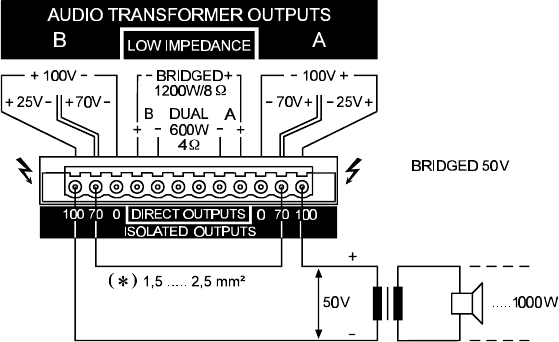
Bridged Mode
Doubling the power amplifier’s output power is accomplished by engaging bridged mode operation, where
the two power amplifier output stages are linked for push-pull operation. In other words, a monaural power
amplifier is “created” offering double the output voltage and double the output power capacity of a single
channel. As a result you are provided with floating 50 V, 140 V, and 200 V as well as with a direct output
with doubled nominal output voltage.
If the BRIDGED-MODE switch is engaged, the audio input signal has to be fed via the CHANNEL A input
while the CHANNEL B input is without function. The signal is internally inverted and the power amplifier
stage B is driven by that inverted signal. The power amplifier stage A is still driven by the unaltered
incoming audio signal. Bridged mode operation is possible with using the isolated and/or the direct outputs.
When using the isolated outputs, bridging the (–) binding posts of channels A and B is mandatory,
using short cables with suitable diameter (1.5 mm
2
... 2.5 mm
2
)!
Careful consideration of the loudspeaker systems’ correct connection is important in preventing phase
correlation problems. Channel A carries the signal “in phase” and therefore has to be connected to the
(+)-pole of the correspondent loudspeaker system while the loudspeakers (–)-pole has to be connected
to the (+)-output connector of channel B. The output voltage of each power amplifier stage A&B is present
at the binding post strip, but utilization is not recommended because of the negative correlation.
figure: output connection in 50 V bridged mode operation
*Caution! The bridging cable has to be at least 1.5 mm
2
in diameter.
Driving 4 ohms loads at the direct output is not admissible in bridged mode operation. For details on
nominal load impedance and nominal loads of the individual outputs in bridged mode operation, please
refer to the specifications in the appendix. Also in bridged mode, the nominal load impedance is not to be
declined.
23
















